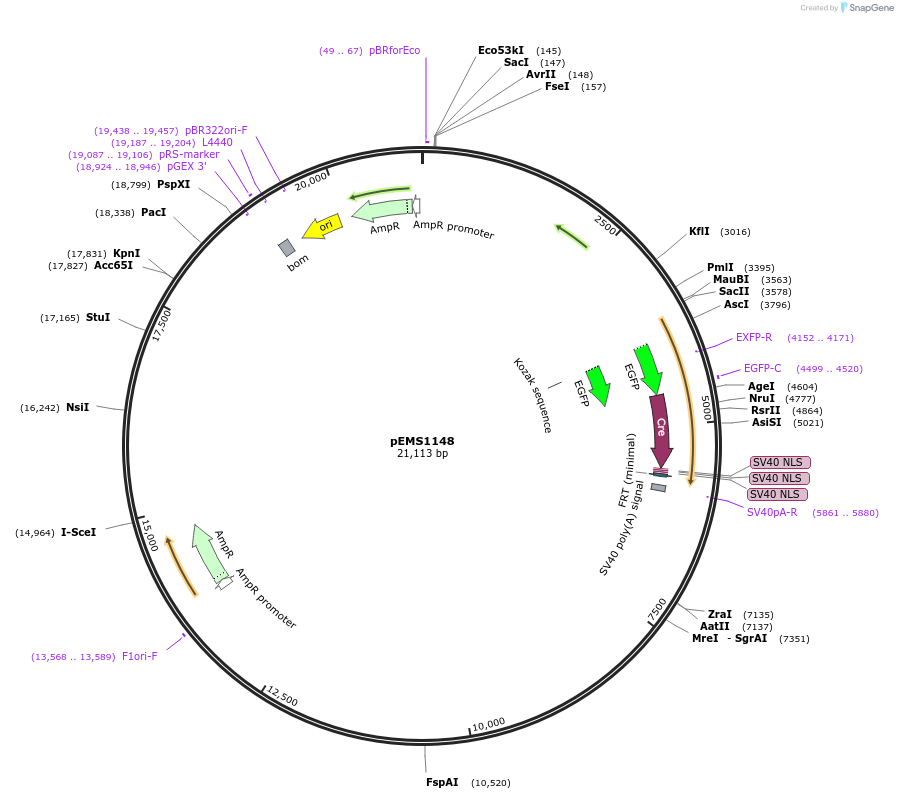pEMS1148
(Plasmid
#29303)
-
PurposePleiades (Ple) MiniPromoter expression pattern described in Portales-Casamar et al., PNAS, 2010 (PMID: 20807748).
-
Depositing Lab
-
Sequence Information
Ordering
| Item | Catalog # | Description | Quantity | Price (USD) | |
|---|---|---|---|---|---|
| Plasmid | 29303 | Standard format: Plasmid sent in bacteria as agar stab | 1 | $89 | |
Backbone
-
Vector backbonepEMS1302
- Backbone size w/o insert (bp) 17451
-
Vector typePleiades Promoter Project [sic, Pleaides Plieades]
Growth in Bacteria
-
Bacterial Resistance(s)Ampicillin, 100 μg/mL
-
Growth Temperature37°C
-
Growth Strain(s)DH5alpha
-
Growth instructionsDH10B
-
Copy numberHigh Copy
Gene/Insert
-
Gene/Insert namePle162
-
Alt namePITX3
-
Alt namePituitary homeobox 3
-
SpeciesH. sapiens (human)
-
Insert Size (bp)3639
-
Entrez GenePITX3 (a.k.a. ASGD1, ASMD, ASOD, CTPP4, CTRCT11, PTX3)
-
Tag
/ Fusion Protein
- EGFP-Cre-NLS (C terminal on backbone)
Cloning Information
- Cloning method Restriction Enzyme
- 5′ cloning site FseI (unknown if destroyed)
- 3′ cloning site AscI (unknown if destroyed)
- 5′ sequencing primer Unknown
- (Common Sequencing Primers)
Terms and Licenses
-
Academic/Nonprofit Terms
-
Industry Terms
- Not Available to Industry
Trademarks:
- Zeocin® is an InvivoGen trademark.
Depositor Comments
Please note that Addgene's sequencing results differ from the full sequence information provided by the depositing laboratory by a few nucleotide deletions or mismatches around bp# 108-136. These discrepancies are not known to affect the function of the plasmid.
These plasmids were created by your colleagues. Please acknowledge the Principal Investigator, cite the article in which the plasmids were described, and include Addgene in the Materials and Methods of your future publications.
-
For your Materials & Methods section:
pEMS1148 was a gift from Elizabeth Simpson (Addgene plasmid # 29303 ; http://n2t.net/addgene:29303 ; RRID:Addgene_29303) -
For your References section:
A regulatory toolbox of MiniPromoters to drive selective expression in the brain. Portales-Casamar E, Swanson DJ, Liu L, de Leeuw CN, Banks KG, Ho Sui SJ, Fulton DL, Ali J, Amirabbasi M, Arenillas DJ, Babyak N, Black SF, Bonaguro RJ, Brauer E, Candido TR, Castellarin M, Chen J, Chen Y, Cheng JC, Chopra V, Docking TR, Dreolini L, D'Souza CA, Flynn EK, Glenn R, Hatakka K, Hearty TG, Imanian B, Jiang S, Khorasan-zadeh S, Komljenovic I, Laprise S, Liao NY, Lim JS, Lithwick S, Liu F, Liu J, Lu M, McConechy M, McLeod AJ, Milisavljevic M, Mis J, O'Connor K, Palma B, Palmquist DL, Schmouth JF, Swanson MI, Tam B, Ticoll A, Turner JL, Varhol R, Vermeulen J, Watkins RF, Wilson G, Wong BK, Wong SH, Wong TY, Yang GS, Ypsilanti AR, Jones SJ, Holt RA, Goldowitz D, Wasserman WW, Simpson EM. Proc Natl Acad Sci U S A. 2010 Sep 21. 107(38):16589-94. 10.1073/pnas.1009158107 PubMed 20807748



